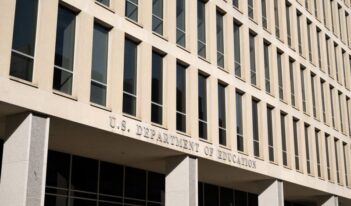
Congress and President Trump use Congressional Review Act to rescind Obama-era education rule.
A little-discussed, 2016 U.S. Department of Education regulation on teacher preparation sought quietly to change what colleges and other institutions that train teachers need to report to the federal government and the public. The rule, which would have become effective this month, was dismantled earlier this spring by a decades-old federal law that has been used more than a dozen times since President Donald Trump’s inauguration, despite only being used once before.
Instead of letting the rule take effect, President Trump signed a bill to rescind what he characterized as an “unnecessary” and “harmful” regulation. Congress passed the bill to rescind the Education Department’s rule under the Congressional Review Act (CRA), which allows Congress to “disapprove” of regulations enacted toward the end of a President’s administration.
The rule, initially adopted at the end of the Obama Administration, had aimed to improve reporting about teacher training programs. The federal government has long required that teacher preparation programs report information for use by state officials and the public. But a 2015 report from the Government Accountability Office found the old reporting requirements to be largely unhelpful. According to the report, despite up to 200 hours of review, state officials claimed they often did not use parts of the required data. Only about half of state officials found the information either “very” or “moderately” useful for approving programs or considering state regulations.
The Education Department’s recent rule aimed to fix this. The regulation would have established eight indicators of program quality that states would have needed to report.
Some of the indicators—teacher satisfaction, employee satisfaction, and program characteristics— would have focused on the training programs themselves. Other indicators would have measured where teachers go after completing their programs; these would have included measures of teacher placement and teacher retention, specifically in high-need schools, as defined by income and poverty levels.
One of the indicators, which had been associated with student learning outcome results, would have measured the success of new teachers’ students. As the Education Department reported in the preamble to the final rule, research from several states shows that students’ performance varies depending on the quality of the program that their teacher attended.
Prior to this rule’s adoption, some states had not been identifying their low-performing teacher preparation programs, as required by law. The Education Department argued that the new requirements would have fixed this problem because the rule would have required states to use the eight indicators to identify low-performing programs.
Under the regulation, states would have been required to assign weights to the eight indicators and use that scoring system to identify low-performing teacher preparation programs. Low-performing programs would have lost their federal funding and would have needed to inform the public and current students of this status.
The new set-up was designed to provide both accountability and transparency, but the Education Department stated at the time of the rules adoption that it did “not expect that a large percentage of programs will be subject to a loss” of funding. It estimated that about 50 of the more than 2,000 teacher preparation programs in the country would have been deemed low performing.
In addition, the rule would have tied program performance to TEACH grants. The TEACH grant awards $4,000 per year to college students who plan to teach for four years in a low-income school after graduation. Under the rule’s provisions, teachers-in-training would have no longer been eligible for these grants if they were to attend a low-performing teacher preparation program; the rule was thus designed to discourage them from attending those low-performing programs.
John King, then-U.S. Secretary of Education under President Obama, described the rule as a positive step towards improving both transparency and quality at teacher preparation programs. He noted that aspiring teachers “need good information to select the right program; school districts need access to the best trained professionals for every opening in every school; and preparation programs need feedback about their graduates’ experiences in schools to refine their programs.”
Others, however, have suggested that more work needs to be done. For instance, two partners at Bellwether Education Partners described the regulations as a tentative, but important, first step in holding these programs accountable.
One of the reasons for creating the rule, according to the Obama Education Department, was that research from some states has demonstrated that learning outcomes vary based on the programs that teachers attend; for this reason, the agency included student learning outcomes as one of the eight indicators that states must use to evaluate program effectiveness. But the rule did not specify how student learning outcomes needed to be measured or how much weight they must be given.
Moreover, using learning outcomes to evaluate teachers and, by extension, the programs that train them, has been controversial. National Education Association President Lily Eskelsen García, head of the country’s largest teacher’s union, has criticized such an approach. Garcia has argued that using “students’ test scores to evaluate educators takes us back to the No Child Left Behind days,” referring to the legislation’s sanctions on schools that failed to meet student-learning goals, as measured by standardized tests. According to Garcia, focusing on test scores ignores class sizes, school resources, and other factors that vary by school but which are beyond a teacher’s control.
On the other hand, supporters of the rule have reportedly noted that Louisiana and Arizona have collected information similar to that which would have been required by the Education Department’s rule and which subsequently showed improvements in student learning.
The controversy over using student-learning goals, though, is not new. In the past, the Education Department has attempted to use student standardized test scores to evaluate teacher preparation programs, but it backed down after sharp criticism. Disagreements about test scores as a measure of school quality were also central when the No Child Left Behind Act was proposed 15 years ago.
The Education Department largely avoided the issue of how to measure learning outcomes in its new rule. The preamble to the final rule noted that states would retain flexibility in measuring student learning outcomes and have the option of establishing additional criteria for evaluating preparation programs.
Nevertheless, the debate over whether this rule would have improved education is left unresolved for the foreseeable future, as the regulation met the fate of congressional disapproval under the Congressional Review Act. Under that Act, not only has the teacher preparation rule been rescinded but also the Department of Education is now precluded from reissuing any substantially similar rule in the future.
Paul Stephan is a student at the University of Pennsylvania Law School and currently a summer associate at the U.S. Government Accountability Office (GAO). He had no involvement in the 2015 GAO report, nor does he write on behalf of the GAO. Any views expressed in this article are his own.



